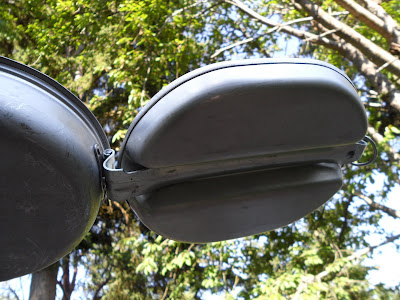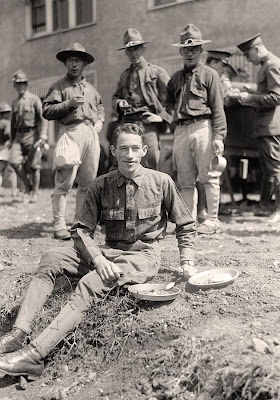As a follow up to the last post on the mint WW2 mess kit, I thought I'd go ahead and drag out some mess silverware, a canteen, and mess kit bag from the dusty attic............. I'll even add in some little tidbits about how the mess kits and gear were used that many people don't know about. Here we go...........
First off I have a WW1 vintage mess kit bag that may, or may not, be US military issue. The light canvas bag is designed to hold the mess kit and silverware. It has two belt loops for wearing on the field belt and an optional shoulder strap. Inside is a had written name and address of a previous owner. This bag could be called a "bread bag" or "mess kit bag"......
Next up is a batch of WW1 US silverware. The silverware that was issued in WW1 was constructed out of stamped and tinned steel. These pieces are dated 1917 and 1918. The "US" marking is stamped on the front and the manufacturer and year made is stamped on the reverse. The WW1 versions of the mess silverware can be distinguished from the WW2 versions by the absence of a hole in the handle (you'll see WW2 versions as we continue on in this post). There's not much more to say about the WW1 silverware, so here are a few photos of the spoon and forks in my collection.
Next up for discussion is a WW1 - WW2 canteen set. This set is a mix of components from the two wars. The canteen is a Model - 1910, welded aluminum, canteen with a metal screw top. This canteen is dated 1918. Prior to this year, none of the US canteens were dated. The US canteens were basically the same all the way into the 1980's. In 1942 the screw caps were changed to Bakelite and the metal body was changed to stainless steel. The canteen cup is not dated and is most likely is a post war version. The cup with the folding handle remained unchanged from 1942 until 1974. In 1974, the handle was changed to a double folding wire set up. Another interesting note about the cups is the lip of the cup itself. originally these cups had a rolled lip, but it was soon discovered that it held too much heat and made it tough to drink hot liquids out of, so in 1942 it was changed to a flared lip. The cup of mine has the flared lip, so it must have been made in 1942 or later. If you look at the cup handle, you will notice two slots in it. These slots are for a fork to be inserted to lift the cup if it was too hot to hold......... if you had heated it over a stove, for example. The canteen cover is a model 1942 canvas cover with a wool liner and the old style wire web belt hanger on the back. There is a very faint makers ID and date on the side. I believe the date is 1945. This would actually be a pretty accurate set up for a WW2 canteen set. When the US entered WW2, there were warehouses filled with WW1 canteens and they were put into use until the need for a new production run in 1942. The WW2 dated canteens can be found with 1942 - 1945 dates, but no 1941's for just this reason.
Here are the photos of the canteen, cup and cover as well a shot showing the cup being used with the fork and slot.
Next up is a set of Model - 1926 (M-26) knives, fork and spoon. The spoon and fork are made of stainless steel and feature the large hole in the handle. The holes were added to the silverware so that they could be threaded onto the handle of the mess kit for washing as a unit after use. The spoon is dated 1952. No date on the fork. The knives also have the same holes in the handle. One knife (the dated 1941) has a carbon steel blade and the other has a stainless steel blade. The knife handles are cast aluminum. One of the knives (the one with the darker blade), is dated 1941 and has the initials of the manufacturer, L.F.&C. . Here are the photos of the Model 1926 silverware:
Here is a photo of the old WW1 style silverware next to the later model 1926 silverware:
As I said earlier, the later model silverware was designed to thread onto the handle of the mess kit so that all of the pieces could be kept together with they were washed after use (usually dipped into cans of boiling water and soapy water). Here's how they were threaded together:
Another interesting thing about the mess kit itself is that it was designed to have the lid-tray hook onto the lower handle so that you could go through the chow line and hold both halves with one hand. Here's how that worked:
And now for some archive photos from WW1 and WW2 showing the silverware, canteens, cups and mess kits in use:
WW1:
 |
| Circa 1900 |
WW2:









































1 comment:
Greetings; I have come into posession of a 1904 brass anvil and stamp marking kit with a stenciled anvil for the knife, fork, spoon, cup, meat can and a round ID tag. It appears to have been used to stendil the mess gear with unit identity with the exception of the ID tag which includes the Nme, rank and unit information. I thought possibly the tag was attached to the bread bag. Any Ideas? contact me at pawclaws@ohiocampcooks.org my pseudonym is Paws
Post a Comment